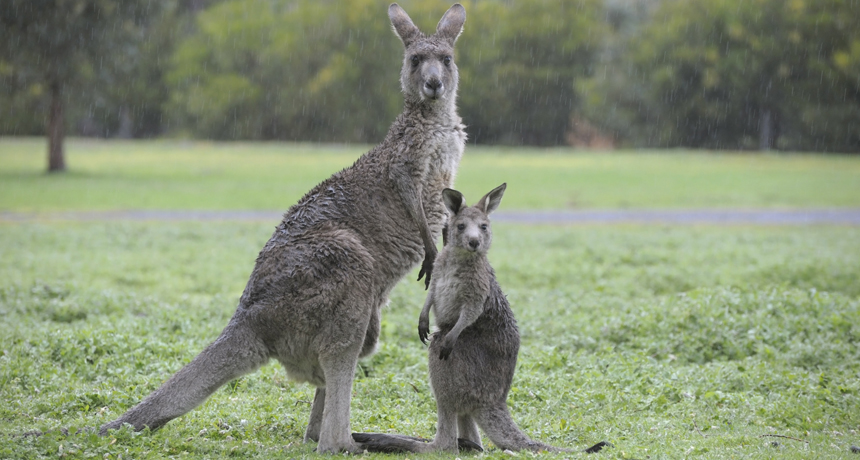Kangaroos have ‘green’ farts
Microbes in the animal's digestive tracts produce less of a potent greenhouse gas than do those of other grass grazers

Microbes from the digestive tract of Eastern gray kangaroos (like the one shown here with her joey) appear to explain the climate-friendly flatulence of these animals.
JohnCarnemolla/iStockphoto
Nearly all animals burp and fart. Kangaroos, however, are special. The gas they pass is easy on the planet. Some might even call it “green” because it contains less methane than emissions from other grass grazers, such as cows and goats. Scientists now credit the ‘roos low-methane toots to the bacteria living inside their digestive tracts.
These researchers hope their new finding could lead to tips for cutting methane emissions from farm animals.
Some chemicals in the atmosphere, known as greenhouse gases, trap incoming heat from the sun. This leads to warming at the Earth’s surface. Methane is one of the most potent of these greenhouse gases. Its impact on global warming is more than 20 times greater than that of carbon dioxide, the best-known greenhouse gas.
Cutting the methane released by livestock could slow global warming. Scott Godwin works for the Queensland Department of Agriculture, Fisheries and Forestry in Brisbane, Australia. He and his coworkers thought studying the germs responsible for kangaroos’ flatulence (ahem, farts) might offer clues on how to do this.
To sniff out the kangaroo’s secret, the microbiologists collected microbes from the digestive tracts of three wild eastern gray kangaroos. They also collected microbes from cows.
These microbes had been dining on the animals’ last grassy meals. The scientists placed the microbes in glass bottles and let them continue to break down the grasses. The bugs do it through a process known as fermentation.
In many animals, this fermentation creates two gases, carbon dioxide and hydrogen. But in animals like cows and goats, other microbes called methanogens gobble up those substances and turn them into methane.
In the kangaroo experiment, the scientists did find some of those methane-making microbes. But some other germs were active too, they reported March 13 in ISME Journal. One key hint: The gas produced by ‘roo microbes smelled unusual — like manure with a bit of vinegar and parmesan cheese.
Among the kangaroos’ microbes were acetogens. These microbes take in carbon dioxide and hydrogen — but make no methane. They instead produce a substance called acetate.
Acetogens compete with methanogens in the digestive tracts of animals. Methanogens usually win, Peter Janssen told Science News. He’s a microbiologist at the New Zealand Agricultural Greenhouse Gas Research Centre in Palmerston North. He did not take part in the new study.
In kangaroos, though, the acetogens often win the battle, the researchers report. The result is fairly low levels of methane.
The new research does not fully explain the greener gas of kangaroos, Janssen says. In fact, it raises questions about why methanogens don’t always win out in kangaroos.
“It’s an important first study,” he says, and the research offers a clue about where to look for answers.
Acetogens also live in the digestive tract of cows, Godwin told Science News. If scientists could find a way to give their acetogens an edge over their methanogens, cows too might produce low-methane farts and burps.
Power Words
acetogen Any of several bacteria that survive in the absence of oxygen, feeding on carbon monoxide (CO) and carbon dioxide (CO2). In the process, they produce acetyl-CoA, also known as activated acetate.
carbon dioxide Agas produced by all animals when the oxygen they inhale reacts with the carbon-rich foods that they’ve eaten. This colorless, odorless gas also is released when organic matter (including fossil fuels like oil or gas) is burned. Carbon dioxide acts as a greenhouse gas, trapping heat in Earth’s atmosphere. Plants convert carbon dioxide into oxygen during photosynthesis, the process they use to make their own food.
fermentation A process that releases energy as microbes feast on materials, breaking them down. One common byproduct: alcohol and short-chain fatty acids. Fermentation is a process used to liberate nutrients from food in the human gut. It also is an underlying process used to make alcoholic beverages, from wine and beer to stronger spirits.
global warming Thegradual increase in the overall temperature of Earth’s atmosphere due to the greenhouse effect. This effect is caused by increased levels of carbon dioxide, chlorofluorocarbons and other gases in the air, many of them released by human activity.
greenhouse gas A gas that contributes to the greenhouse effect by absorbing heat. Carbon dioxide is one example of a greenhouse gas.
hydrogen The lightest element in the universe. As a gas, it is colorless, odorless and highly flammable. It’s an integral part of many fuels, fats and chemicals that make up living tissues.
methane A hydrocarbon with the chemical formula CH4 (meaning there are four hydrogen atoms bound to one carbon atom). It’s a natural constituent of what’s known as natural gas. It’s also emitted by decomposing plant material in wetlands and is belched out by cows and other ruminant livestock. From a climate perspective, methane is 20 times more potent than carbon dioxide is in trapping heat in Earth’s atmosphere, making it a very important greenhouse gas.
methanogens Microbes — principally archaea — that release methane as a byproduct of their breakdown of food.
microbe (short for microorganism) A living thing that is too small to see with the unaided eye, including bacteria, some fungi and many other organisms such as amoebas. Most consist of a single cell.
microbiology The study of microorganisms. Scientists who study microbes and the infections they can cause or ways that they can interact with their environment are known as microbiologists.







